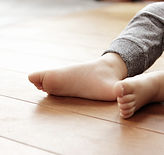
Flat Feet
Flat Feet
Flat feet are a common condition in infants and toddlers, the longitudinal arch is not developed and flat feet are normal. The arch develops in childhood, and by adulthood, most people have developed normal arches. Most feet are flexible and an arch appears when the person stands on his or her toes. Stiff, inflexible or painful flat feet may be associated with other conditions and require medical attention.
Most flat feet usually do not cause pain or other problems. Flat feet may be associated with pronation, a leaning inward of the ankle bones toward the center line. Shoes of children who pronate, when placed side by side, will lean toward each other (after they have been worn long enough for the foot position to remodel their shape). Foot pain, ankle pain or lower leg pain, especially in children, may be a result of flat feetand should be evaluated.
Painful progressive flatfoot, otherwise known as Tibialis Posterior Tendonitis, is caused by inflammation. The tendon becomes inflamed, stretched or suffers a partial or total tear. If left untreated, this condition may lead to severe disability and chronic pain. Some people are prone to this condition if they have flatfeet or an abnormal attachment of the tendon to the bones in the midfoot.
Nonsteroidal anti-inflammatory medications, ice, physical therapy, supportive taping and bracing, or orthotic devices are the common ways of treating painful progressive flatfoot. Consult with your physician before taking any medications. Surgical intervention involves repairing the torn or damaged tendon to restore normal function. To prevent re-injury, orthotic devices or shoe inserts may be recommended. In severe cases, surgery on the midfoot bones may be necessary to treat the associated flatfoot condition.

Flat
Normal
High
Very High



Click
to View
Normal Arch vs Flat Feet
What are some common uses of the procedure?
Test Yourself for Flat Feet
You can easily test yourself to see if you might have fallen arches or flat feet. Follow these three steps:
-
Get your feet wet.
-
Stand on a flat surface where your footprint will show, such as on a concrete walkway.
-
Step away and look at the prints. If you see complete imprints of the bottom of your feet on the surface, surface you're likely to have flat feet
What are some common uses of the procedure?
Causes of Flat Feet and Fallen Arches
Flat feet in adults can arise from a variety of causes.
-
An abnormality that is present from birth
-
Stretched or torn tendons
-
Damage or inflammation of the posterior tibial tendon (PTT), which connects from your lower leg, along your ankle, to the middle of the arch
-
Broken or dislocated bones
-
Some health conditions, such as rheumatoid arthritis
-
Nerve problems

.png)
.png)





